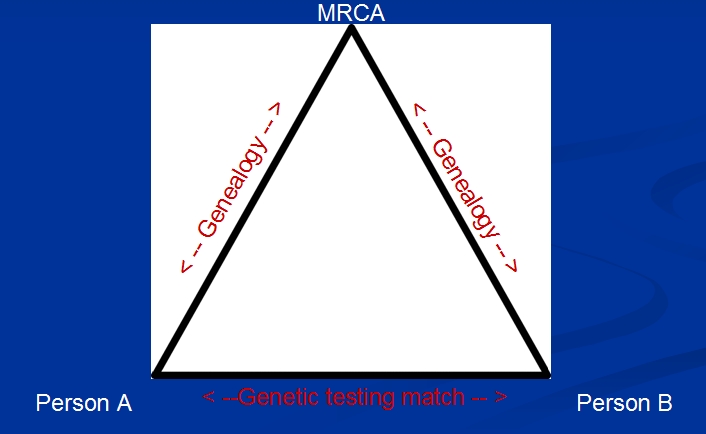Triangulation of Genetic Matches
It has been my experience that the secret to great success is practice, practice and more practice. I believe it will be the same as I develop a fully transparent methodology for the process of successfully doing genetic triangulation to find common ancestors. An important part of this process is that each result will be reviewed by others who are stakeholder's in the outcome. A listing of triangulation proof pages will begin to appear on the menu section on this page. Each case will receive it's own page which can be book marked and easily referenced.

Source: http://www.isogg.org/wiki/Triangulation
Triangulation is a term derived from surveying to describe a method of determining the Y-STR or mitochondrial DNA ancestral haplotype using two or more known data points. The term "Genetic Triangulation" was coined by genetic genealogist Bill Hurst in 2004.
The technique is also used in autosomal DNA testing to compare matching DNA segments to determine which ancestor donated which particular segment. To get started make a spreadsheet with segment data and look for overlapping segments from a common ancestor. If you have at least three people with the common ancestor matching on the same segment then you can infer that the segment came from that ancestor. However, caution needs to be exercised as it is still possible that the match is a false positive (identical by state). This is particularly the case with small segments below 11 cMs.
Triangulation is best used in autosomal DNA testing in combination with chromosome mapping. The process of triangulating segments is greatly facilitated by the use of third-party tools such as those available from GedMatch and DNAGEDCOM (eg, Don Worth's Autosomal DNA Segment Analyser).
The basics of triangulation
Genetic triangulation is rather simple. Think of a triangle. /_\
Person A & B match genetically and that forms the base of the triangle. _
Person A has a paper trail (genealogy) that goes back in time. /
Person B has a paper trail that goes back in time. \
The top of the triangle is the MRCA or most recent common ancestor.
For Y-DNA testing: Person A is who you are testing. Some living biological male 2nd, 3rd or better cousin could be Person B. The most common shared ancestor is the MRCA.
For other DNA testing: Person A is who you are testing. Another person is Person B. The most common shared ancestor is the MRCA.
If the genetics of Person A & Person B match and the paper trail goes to the MRCA, then this helps prove they are related both genealogically and genetically. This is the goal of genetic genealogy. When this is repeated several times back to a common ancestor, we then can recreate the DNA markers or fingerprint of that ancestor. All without digging them up!
This is the goal of genetic genealogy. The genetics help confirm the paper trails (genealogy) back to the MRCA.
If there is a break in any point of the triangle, it should be noted appropriately.
---If Person A & B match genetically but either paper trail (genealogy) does not go back to the MRCA, then they match genetically but not genealogically.
---If Person A & B do not match genetically, but match with the paper trails, then they match genealogically, but not genetically. In this case the genealogy may be wrong or there is a formal or informal adoption of DNA into the genealogical line. The later is called a non-paternal event.
When comparing any DNA test using triangulations, one should always cite the common test. For example, When comparing say a 37 marker Y-DNA test with 111 marker Y-DNA test, you should always cite the lower value. Using the example given, a proper statement of genetic triangulation would indicate that Person A & Person B matched genetically and genealogically at 37 Y-DNA markers.
|